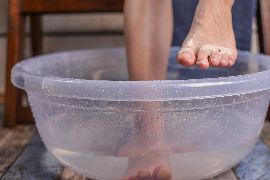
Prolonged standing leads to stiff muscles and chronic foot pain. Although proper shoes can help, many are stuck wearing required footwear such as high heels and pointed ones. If your work involves being in a fixed position all day, consider these four healthy tips to avoid foot pain from affecting your everyday life.
How to Alleviate Foot Pain
1. Stretch
Stretching the feet and ankles strengthens the muscle to provide better support. Try stretching after work to relieve sore muscles and increase circulation. For example, if you have heel pain, do the asterisk exercise to strengthen the heel and the ball of the big and little toes. First, stand tall with your feet together. Next, lift one foot and take it upfront as far as possible to create an asterisk pattern with seven different points. Then, repeat on the other feet. This exercise also elongates foot muscles to help prevent spasms and contractions. Another simple stretching to consider is writing the alphabet using your toes. This relieves tension on the top of the foot due to tight shoes.
2. Soak

Prolonged standing and walking pull the water in the blood to enter the lower extremities causing them to swell. After work, reduce the inflammation with alternating warm and cold foot baths. This process changes blood movement, reducing swelling to relieve foot and joint tension. Start by submerging your limbs in ice-cold water for about two minutes. Then, move them to a second bucket with lukewarm water for 30 seconds.
3. Use Tennis Ball or Foam Roller
Remaining upright for long durations strains the body and lower leg muscles. As a result, alleviating the feet muscles during or after work helps relieve the pressure from carrying your weight all day. Start with using a tennis ball and place it under your foot. Then, roll it back and forth to allow the pressure to lengthen the muscle.
Additionally, consider stretching the calves and thighs with the foam roller to soothe the tired muscles. First, sit on a flat surface and place the roller on the back of one leg. Then, rest the other on the floor. Next, use your hands to roll from the ankle to below the knee to release muscle tightness.
4. Alternate Shoes
Uncomfortable shoes can aggravate pain. Try alternating work shoes with comfortable shoes with a thick cushioned insole before going and leaving work to avoid heel pain. If you can, try switching to low-heeled shoes for better function. Additionally, avoid wearing tight shoes, which can lead to painful ingrown toenails.
If the pain worsens, contact Westside Podiatry Group in Rochester, NY. For over 50 years, this team of podiatrists has provided specialized treatment for ankle sprains, heel pain, and other foot problems associated with diabetic complications. In addition, they provide a personal treatment plan and long-term solution for painful ingrown toenails and bunions. Visit their website to learn more about their treatments, or call (585) 225-2290 to schedule an appointment.
About the Business
Have a question? Ask the experts!
Send your question

